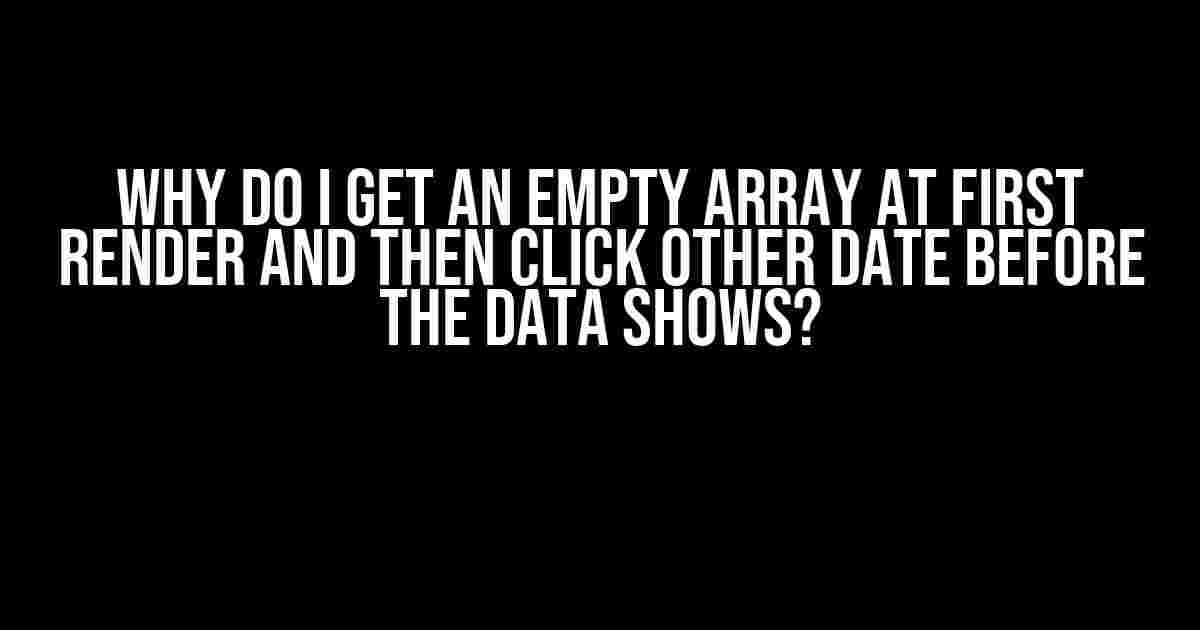Are you tired of scratching your head, wondering why your code is not working as expected? Well, you’re not alone! Many of us have been there, done that, and got the t-shirt. In this article, we’ll dive into the mysterious world of React, where the data seems to be playing hide and seek, leaving us with an empty array at first render and then, suddenly, appearing after clicking on a different date. Sounds like a puzzle, right? Let’s break it down and find out what’s going on!
The Culprit: Asynchronous Data Fetching
The main reason behind this phenomenon is the asynchronous nature of data fetching. When you make an API call or fetch data from a database, it takes some time to receive the response. In the meantime, your React component is rendered, and, initially, the state is empty. In other words, your data hasn’t arrived yet! It’s like waiting for a package to be delivered; you can’t wear the clothes before they arrive.
import React, { useState, useEffect } from 'react';
function MyComponent() {
const [data, setData] = useState([]);
const [date, setDate] = useState(new Date());
useEffect(() => {
fetch(`https://my-api.com/data?date=${date.toLocaleDateString()}`)
.then(response => response.json())
.then(data => setData(data));
}, [date]);
return (
Selected Date: {date.toLocaleDateString()}
Data: {data.length > 0 ? data.join(', ') : 'Empty Array'}
);
}
What’s Happening Behind the Scenes?
Let’s break down the code:
- The component mounts, and the `useEffect` hook is triggered.
- The API call is made with the initial `date` state.
- The component is rendered with an empty `data` array.
- When the API response arrives, the `setData` function is called, updating the `data` state.
- Since the component has already been rendered, the updated `data` state doesn’t trigger a rerender.
- When you click the “Next Day” button, the `date` state is updated, triggering the `useEffect` hook again.
- The API call is made with the new `date` state, and the `data` state is updated when the response arrives.
- This time, the component is rerendered with the updated `data` state, and you see the actual data!
Solutions to the Puzzle
Now that we’ve identified the culprit, let’s find some solutions to this problem:
-
Use a Loading Indicator
Show a loading indicator while the data is being fetched, and hide it when the data arrives. This way, the user knows that something is happening behind the scenes.
{data.length > 0 ? (Data: {data.join(', ')}
) : (
Loading...
)}
-
Initial Data Fetching on Mount
Use the `useEffect` hook with an empty dependency array to fetch the data only once, when the component mounts.
useEffect(() => {
fetch(`https://my-api.com/data?date=${date.toLocaleDateString()}`)
.then(response => response.json())
.then(data => setData(data));
}, []);
-
Use a Cache or Memoization
Implement a cache or memoization to store the fetched data and return it immediately when the component is rerendered with the same date.
const cache = {};useEffect(() => {
if (!cache[date.toLocaleDateString()]) {
fetch(`https://my-api.com/data?date=${date.toLocaleDateString()}`)
.then(response => response.json())
.then(data => {
cache[date.toLocaleDateString()] = data;
setData(data);
});
} else {
setData(cache[date.toLocaleDateString()]);
}
}, [date]);
-
Data Preprocessing
Preprocess the data on the server-side or during the API call, so that the response is already formatted and ready to be displayed.
fetch(`https://my-api.com/data?date=${date.toLocaleDateString()}`)
.then(response => response.json())
.then(data => {
const formattedData = data.map(item => item.name);
setData(formattedData);
});
Conclusion
In conclusion, the empty array at first render and then the data showing up after clicking on a different date is a classic symptom of asynchronous data fetching. By understanding the lifecycle of your React component and the nature of data fetching, you can implement the right solutions to this problem. Whether it’s using a loading indicator, initial data fetching on mount, caching, or data preprocessing, you now have the tools to tackle this challenge head-on!
| Solution | Description |
|---|---|
| Loading Indicator | Show a loading indicator while data is being fetched |
| Initial Data Fetching on Mount | Fetch data only once when the component mounts |
| Caching or Memoization | Store fetched data and return it immediately on rerender |
| Data Preprocessing | Format data on the server-side or during API call |
Frequently Asked Question
Getting an empty array at first render and then clicking on another date before the data shows? Don’t worry, we’ve got you covered! Check out these FAQs to solve the mystery!
Why does my data only show up after clicking on another date?
This is likely due to the asynchronous nature of your data fetching. When your component mounts, the data might not be available yet, resulting in an empty array. Once you click on another date, the component re-renders, and the data is fetched again, this time successfully displaying the data.
Is it a problem with my API or data source?
Not necessarily! It’s more likely an issue with when and how you’re fetching the data in your component. Double-check your API calls and data fetching logic to ensure it’s correct and efficient.
How can I make sure my data is fetched before the component mounts?
You can use the `useState` and `useEffect` hooks to fetch your data before the component mounts. Initialize your state with a loading indicator, and then fetch the data in the `useEffect` hook. Once the data is fetched, update your state, and the component will re-render with the data.
Will using a library like Redux or MobX solve this issue?
Possibly! State management libraries like Redux or MobX can help manage your data and ensure it’s available when your component mounts. However, it’s essential to understand how these libraries work and implement them correctly to avoid other issues.
What if I’m using React’s Context API for state management?
If you’re using the Context API, make sure you’re providing the data to your component correctly. Check that your context provider is fetching the data before the component mounts, and that your component is consuming the context correctly.
